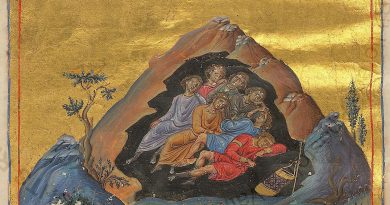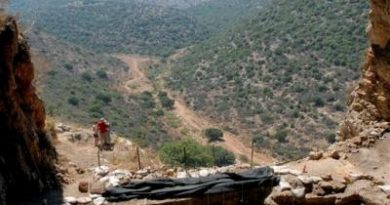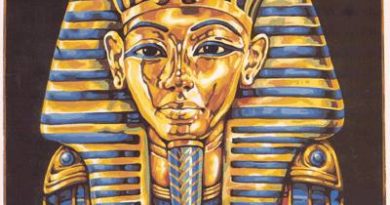The Rosetta Stone
The Rosetta Stone is 3 feet 9 inches long and 2 feet 41/2 inches wide – (114x72x28cm). It is dark grey-pinkish granite stone (originally thought to be basalt in composition) with writing on it in two languages, Egyptian and Greek, using three scripts, Hieroglyphic, Demotic Egyptian and Greek. Because Greek was well known, the stone was the key to deciphering the hieroglyphs.
The Rosetta stone is dated to March 196 BC, in the 9th year of Ptolemy V. The background to the setting up of the stela was the confirmation of the control of the Ptolemaic kings over Egypt. The Ptolemies were Greeks who had been ruling Egypt since the fragmentation of the Empire of Alexander the Great, and while they built temples in the Egyptian style, their lifestyle and language remained exclusively Greek. Egypt had by now become a multi-cultural society, a mixture of Greek and Egyptian, although in many parts of the country the two rarely met.
In the years preceding the setting up of the Rosetta Stone, control of certain parts of Egypt had been lost to the family of the Ptolemies, and it had taken the Ptolemaic armies some time to put down opposition in the Delta; parts of southern Upper Egypt, particularly Thebes, were not yet back in the control of the government. It appears that it was decided that the best way to emphasise the legitimacy of the 13 year old Ptolemy V in the eyes of the Egyptian elite was to re-emphasise his traditional royal credentials with a coronation ceremony in the city of Memphis, and to affirm his royal cult throughout Egypt. This second aim was done through a series of priestly decrees, of which the Rosetta Stone is by far the best-known example. It is a version of the decree issued at the city of Memphis; others include the Canopus decree in the Egyptian Museum in Cairo.
The inscription begins with praise of Ptolemy, and then includes an account of the siege of the city of Lycopolis (a town in the Delta, not identified with certainty), and the good deeds done by the king for the temples. The final part of the text describes the decree’s overriding purpose, the establishment of the cult of the king. For example, it stipulates how the priests shall maintain the cult of the king (‘…the priests shall pay homage three times a day…’), how the king’s shrine is to be set up (‘…there shall be set upon the shrine the ten gold crowns of the king…’), and days when certain festivals, such as the king’s birthday, shall be celebrated. It ends by saying that it is to be made known that all the men of Egypt should magnify and honour Ptolemy V, and that the text should be set up in hard stone in the three scripts which it still bears today.
The Egyptians had used hieroglyphic script for nearly 3,500 years, from 3100 BC until the end of the fourth century AD. At about the turn of the third century AD the Egyptians began to write their languages in a script composed of the Greek alphabet, to which were added seven characters derived ultimately from hieroglyphs. In this form the languages came to be known as Coptic, no doubt a corruption of the Greek word Aiguptios. Knowledge of how to read and write the hieroglyphic script was probably lost soon after it had been superseded and no key to its meaning was found until the discovery of the Rosetta Stone. The deciphering began with the work of the British physicist Thomas Young. He showed that both the demotic and hieroglyphic writing contained both alphabetic and symbolic elementswhich were closely related.
French Captain Pierre-Francois Bouchard (sometimes spelled Boussard) (1772-1832) discovered the stone in the Egyptian port city of Rosetta (present-day Rashid) on July 15, 1799. Some scientists accompanied Napoleon’s French campaign in Egypt (1798-1801). After Napoleon Bonaparte founded the Institut de l’Egypte in Cairo in 1798 some 50 became members of it. Bouchard found a black stone when guiding construction works in the Fort Julien near the city of Rosetta. He immediately understood the importance of the stone and showed it to General Abdallah Jacques de Menou who decided that it should be brought to the institute, where it arrived in August, 1799.
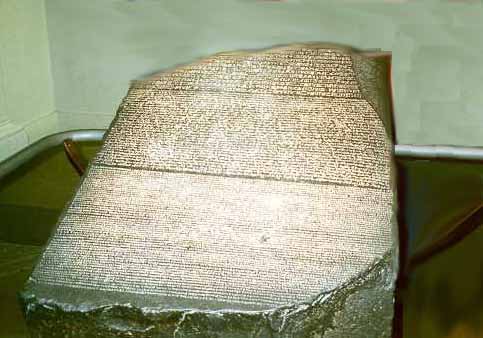
In 1801 the French had to surrender. A dispute arose about the results of the scientists – the French wishing to keep them, while the British considered them forfeit in the name of King George III. The French scientist Etienne Geoffroy Saint-Hilaire, writing to the English diplomat William Richard Hamilton, threatened to burn all their discoveries, ominously referring to the burned Library of Alexandria. The British gave in and insisted only on the delivery of the monuments. The French tried to hide the Rosetta Stone in a boat despite the clauses of the capitulation, but failed. The French were allowed to take the imprints they had made previously, when embarking in Alexandria. When it was brought back to Britain, it was presented to the British Museum, where it has been kept since 1802.
In 1814 Thomas Young finished translating the enchorial (demotic) text, and went on to work on the hieroglyphic alphabet.
In 1822 French Egyptologist Jean Francois Champollion, with the aid of the Coptic language (language of the Christian descendants of the ancient Egyptians) – succeeded in realizing the phonetic value of the hieroglyphs. This proved the fact that hieroglyphs do not have only symbolic meaning, but that they also served as a “spoken language”. The stunning realization that the stone contained the same passage written three times in three different languages allowed it be become and ancient Code Book.
Champollion greatly expanded his research from 1822-1824 and is known as the translator of the Rosetta Stone.
“Rosetta Stone” is also used as a metaphor to refer to anything that is a critical key to a process of decryption, translation, or a difficult problem.
History of the Rosetta Stone
Modern-era discovery
In preparation for Napoleon’s 1798 campaign in Egypt, the French brought with them 167 scientists, scholars and archaeologists known as the ‘savants’. French Army engineer Lieutenant Pierre-François Bouchard discovered the stone sometime in mid-July 1799, first official mention of the find being made after the 25th in the meeting of the savants’ Institut d’Égypte in Cairo. It was spotted in the foundations of an old wall, during renovations to Fort Julien near the Egyptian port city of Rashid (Rosetta) and sent down to the Institute headquarters in Cairo. After Napoleon returned to France shortly after the discovery, the savants remained behind with French troops which held off British and Ottoman attacks for a further 18 months. In March 1801, the British landed at Aboukir Bay and scholars carried the Stone from Cairo to Alexandria alongside the troops of Jacques-Francois Menou who marched north to meet the enemy; defeated in battle, Menou and the remnant of his army fled to fortified Alexandria where they were surrounded and immediately placed under siege, the stone now inside the city. Overwhelmed by invading Ottoman troops later reinforced by the British, the remaining French in Cairo capitulated on June 22, and Menou admitted defeat in Alexandria on August 30.
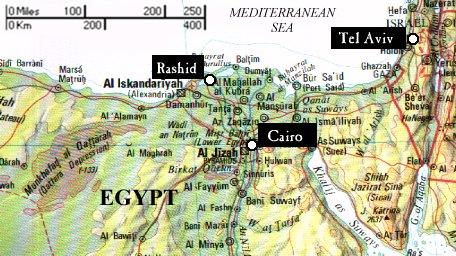
After the surrender, a dispute arose over the fate of French archaeological and scientific discoveries in Egypt. Menou refused to hand them over, claiming they belonged to the Institute. British General John Hely-Hutchinson, 2nd Earl of Donoughmore, refused to relieve the city until de Menou gave in. Newly arrived scholars Edward Daniel Clarke and William Richard Hamilton agreed to check the Rosetta Stone collections in Alexandria and found many artefacts that the French had not revealed.
When Hutchinson claimed all materials were property of the British Crown, a French scholar, Étienne Geoffroy Saint-Hilaire, said to Clarke and Hamilton that they would rather burn all their discoveries referring ominously to the destruction of the Library of Alexandria than turn them over. Clarke and Hamilton pleaded their case and Hutchinson finally agreed that items such as biology specimens would be the scholars’ private property. But Menou regarded the stone as his private property and hid it.
How exactly the Stone came to British hands is disputed. Colonel Tomkyns Hilgrove Turner, who escorted the stone to Britain, claimed later that he had personally seized it from Menou and carried it away on a gun carriage. In his much more detailed account however, Clarke stated that a French ‘officer and member of the Institute’ had taken him, his student John Cripps, and Hamilton secretly into the back-streets of Alexandria, revealing the stone among Menou’s baggage, hidden under protective carpets. According to Clarke this savant feared for the stone’s safety should any French soldiers see it. Hutchinson was informed at once, and the stone taken away, possibly by Turner and his gun-carriage. French scholars departed later with only imprints and plaster casts of the stone.
Turner brought the stone to Britain aboard the captured French frigate HMS Egyptienne landing in February 1802. On March 11, it was presented to the Society of Antiquaries of London and Stephen Weston played a major role in the early translation. Later it was taken to the British Museum, where it remains to this day. Inscriptions painted in white on the artefact state “Captured in Egypt by the British Army in 1801” on the left side and “Presented by King George III” on the right.
Translation
Experts inspecting the Rosetta Stone during the International Congress of Orientalists of 1874
In 1814, Briton Thomas Young finished translating the enchorial (demotic) text, and began work on the hieroglyphic script but he did not succeed in translating them. From 1822 to 1824 the French scholar, philologist, and orientalist Jean-François Champollion greatly expanded on this work together with the efforts of other translators such as Athanasius Kircher, Silvestre de Sacy, Johan David Akerblad and William John Bankes. He is generally credited as being the principal translator of the Rosetta Stone. Champollion could read both Greek and Coptic, and figured out what the seven Demotic signs in Coptic were. By looking at how these signs were used in Coptic, he worked out what they meant. Then he traced the Demotic signs back to hieroglyphic signs. By working out what some hieroglyphs stood for, he transliterated the text from the Demotic (or older Coptic) and Greek to the hieroglyphs by first translating Greek names which were originally in Greek, then working towards ancient names that had never been written in any other language. Champollion then created an alphabet to decipher the remaining text.
In 1858, the Philomathean Society of the University of Pennsylvania published the first complete English translation of the Rosetta Stone as accomplished by three of its undergraduate members: Charles R Hale, S Huntington Jones, and Henry Morton.
Reading the Rosetta Stone
Prior to the discovery of the Rosetta Stone and its eventual decipherment, there had been no understanding of the Ancient Egyptian language and script since shortly before the fall of the Roman Empire. The usage of the hieroglyphic script had become increasingly specialised even in the later Pharaonic period; by the 4th century AD, few Egyptians were capable of reading hieroglyphs. Monumental use of hieroglyphs ceased after the closing of all non-Christian temples in the year 391 by the Roman Emperor Theodosius I; the last known inscription, found at Philae and known as The Graffito of Esmet-Akhom, is dated to 24 August 396 AD.
Hieroglyphs retained their pictorial appearance and classical authors emphasised this aspect, in sharp contrast to the Greek and Roman alphabets. For example, in the 5th century the priest Horapollo wrote Hieroglyphica, an explanation of almost 200 glyphs. Believed to be authoritative yet in many ways misleading, this and other works were a lasting impediment to the understanding of Egyptian writing. Later attempts at deciphering hieroglyphs were made by Arab historians in medieval Egypt during the 9th and 10th centuries. Dhul-Nun al-Misri and Ibn Wahshiyya were the first historians to study this ancient script, by relating them to the contemporary Coptic language used by Coptic priests in their time. The study of hieroglyphs continued with fruitless attempts at decipherment by European scholars, notably Johannes Goropius Becanus in the 16th century, Athanasius Kircher in the 17th and Georg Zoëga in the 18th. The discovery of the Rosetta Stone in 1799 would provide critical missing information, gradually revealed by a succession of scholars, that eventually allowed Jean-François Champollion to determine the nature of this mysterious script.
Greek text
“Illustration depicting the rounded-off lower-right edge of the Rosetta Stone, showing Richard Porson’s suggested reconstruction of the missing Greek text”
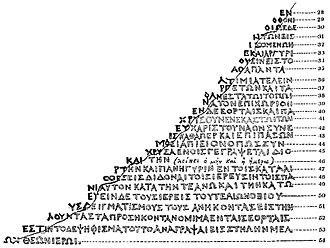
Richard Porson’s suggested reconstruction of the missing Greek text (1803)
The Greek text on the Rosetta Stone provided the starting point. Ancient Greek was widely known to scholars, but the details of its use in the Hellenistic period as a government language in Ptolemaic Egypt were not familiar: large scale discoveries of Greek papyri were a long way in the future. Thus the earliest translations of the Greek text of the stone show the translators still struggling with the historical context and with administrative and religious jargon. Stephen Weston verbally presented an English translation of the Greek text at a Society of Antiquaries meeting in April 1802. Meanwhile, two of the lithographic copies made in Egypt had reached the Institut de France in Paris, in 1801. There, the librarian and antiquarian Gabriel de La Porte du Theil set to work on a translation of the Greek. Almost immediately dispatched elsewhere on Napoleon’s orders, he left his unfinished work in the hands of a colleague, Hubert-Pascal Ameilhon, who in 1803 produced the first published translations of the Greek text, in both Latin and French to ensure that they would circulate widely. At Cambridge, Richard Porson worked on the missing lower right corner of the Greek text. He produced a skilful suggested reconstruction, which was soon being circulated by the Society of Antiquaries alongside its prints of the inscription. At Göttingen at almost the same moment, the Classical historian Christian Gottlob Heyne, working from one of these prints, made a new Latin translation of the Greek text that was more reliable than Ameilhon’s. First published in 1803, it was reprinted by the Society of Antiquaries, alongside Weston’s previously unpublished English translation, Colonel Turner’s narrative, and other documents, in a special issue of its journal Archaeologia in 1811.
Demotic text
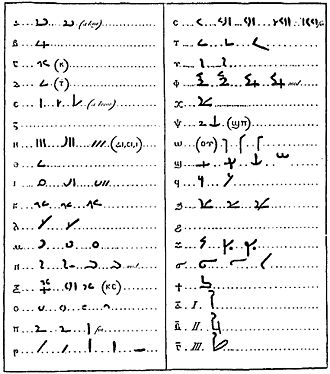
Johan David Åkerblad’s table of Demotic phonetic characters and their Coptic equivalents (1802)
At the time of the stone’s discovery, the Swedish diplomat and scholar Johan David Åkerblad was working on a little-known script of which some examples had recently been found in Egypt, which came to be known as Demotic. He called it “cursive Coptic” because, although it had few similarities with the later Coptic script, he was convinced that it was used to record some form of the Coptic language (the direct descendant of Ancient Egyptian). The French Orientalist Antoine-Isaac Silvestre de Sacy, who had been discussing this work with Åkerblad, received in 1801 from Jean-Antoine Chaptal, French minister of the interior, one of the early lithographic prints of the Rosetta Stone, and realised that the middle text was in this same script. He and Åkerblad set to work, both focusing on the middle text and assuming that the script was alphabetic. They attempted, by comparison with the Greek, to identify within this unknown text the points where Greek names ought to occur. In 1802, Silvestre de Sacy reported to Chaptal that he had successfully identified five names (“Alexandros”, “Alexandreia”, “Ptolemaios”, “Arsinoe” and Ptolemy’s title “Epiphanes”), while Åkerblad published an alphabet of 29 letters (more than half of which were correct) that he had identified from the Greek names in the demotic text. They could not, however, identify the remaining characters in the demotic text, which, as is now known, included ideographic and other symbols alongside the phonetic ones.
Hieroglyphic text
Silvestre de Sacy eventually gave up work on the stone, but he was to make another contribution. In 1811, prompted by discussions with a Chinese student about Chinese script, Silvestre de Sacy considered a suggestion made by Georg Zoëga in 1797 that the foreign names in Egyptian hieroglyphic inscriptions might be written phonetically; he also recalled that as long ago as 1761, Jean-Jacques Barthélemy had suggested that the characters enclosed in cartouches in hieroglyphic inscriptions were proper names. Thus, when Thomas Young, foreign secretary of the Royal Society of London, wrote to him about the stone in 1814, Silvestre de Sacy suggested in reply that in attempting to read the hieroglyphic text, Young might look for cartouches that ought to contain Greek names, and try to identify phonetic characters in them.
“A page containing three columns of characters, the first column depicting characters in Greek and the second and third columns showing their equivalents in demotic and in hieroglyphs respectively”
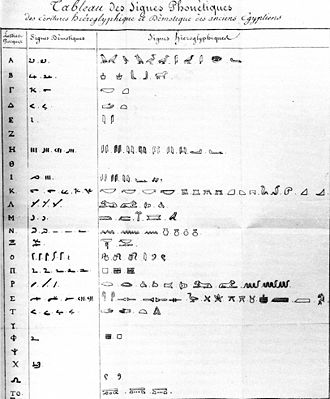
Champollion’s table of hieroglyphic phonetic characters with their demotic and Coptic equivalents (1822)
Young did so, with two results that together paved the way for the final decipherment. He discovered in the hieroglyphic text the phonetic characters “p t o l m e s” (in today’s transliteration “p t w l m y s”), that were used to write the Greek name “Ptolemaios”. He also noticed that these characters resembled the equivalent ones in the Demotic script, and went on to note as many as 80 similarities between the hieroglyphic and demotic texts on the stone, an important discovery because the two scripts were previously thought to be entirely different from one another. This led him to deduce correctly that the demotic script was only partly phonetic, also consisting of ideographic characters imitated from hieroglyphs. Young’s new insights were prominent in the long article “Egypt” that he contributed to the Encyclopædia Britannica in 1819. He could, however, get no further.
In 1814, Young first exchanged correspondence about the stone with Jean-François Champollion, a teacher at Grenoble who had produced a scholarly work on Ancient Egypt. Champollion, in 1822, saw copies of the brief hieroglyphic and Greek inscriptions of the Philae obelisk, on which William John Bankes had tentatively noted the names “Ptolemaios” and “Kleopatra” in both languages. From this, Champollion identified the phonetic characters k l e o p a t r a (in today’s transliteration q l i? w p ? d r ? .t). On the basis of this and the foreign names on the Rosetta Stone, he quickly constructed an alphabet of phonetic hieroglyphic characters, which appears, printed from his hand-drawn chart, in his “Lettre à M. Dacier”, addressed at the end of 1822 to Bon-Joseph Dacier, secretary of the Paris Académie des Inscriptions et Belles-Lettres and immediately published by the Académie. This “Letter” marks the real breakthrough to reading Egyptian hieroglyphs, not only for the alphabet chart and the main text, but also for the postscript in which Champollion notes that similar phonetic characters seemed to occur not only in Greek names but also in native Egyptian names. During 1823, he confirmed this, identifying the names of pharaohs Ramesses and Thutmose written in cartouches in far older hieroglyphic inscriptions that had been copied by Bankes at Abu Simbel and sent on to Champollion by Jean-Nicolas Huyot. From this point, the stories of the Rosetta Stone and the decipherment of Egyptian hieroglyphs diverge, as Champollion drew on many other texts to develop a first Ancient Egyptian grammar and a hieroglyphic dictionary, both of which were to be published after his death.
Later work
Work on the stone now focused on fuller understanding of the texts and their contexts by comparing the three versions with one another. In 1824, the Classical scholar Antoine-Jean Letronne promised to prepare a new literal translation of the Greek text for Champollion’s use; Champollion promised in return an analysis of all the points at which the three texts seemed to differ. At Champollion’s sudden death in 1832, his draft of this analysis could not be found, and Letronne’s work stalled. At the death in 1838 of François Salvolini, Champollion’s former student and assistant, this and other missing drafts were found among his papers (incidentally demonstrating that Salvolini’s own publication on the stone, in 1837, was plagiarism). Letronne was at last able to complete his commentary on the Greek text and his new French translation of it, which appeared in 1841. During the early 1850s, two German Egyptologists, Heinrich Brugsch and Max Uhlemann, produced revised Latin translations based on the demotic and hieroglyphic texts; the first English translation, the work of three members of the Philomathean Society at the University of Pennsylvania, followed in 1858.
The question of whether one of the three texts was the standard version from which the other two were originally translated has remained controversial. Letronne, in 1841, attempted to show that the Greek version (that of the Egyptian government under its Ptolemaic dynasty) was the original.[P] Among recent authors, John Ray has stated that “the hieroglyphs were the most important of the scripts on the stone: they were there for the gods to read, and the more learned of their priesthood”. Philippe Derchain and Heinz Josef Thissen have argued that all three versions were composed simultaneously, while Stephen Quirke sees in the decree “an intricate coalescence of three vital textual traditions”. Richard Parkinson points out that the hieroglyphic version, straying from archaic formalism, occasionally lapses into language closer to that of the demotic register that the priests more commonly used in everyday life. The fact that the three versions cannot be matched word for word helps to explain why its decipherment has been more difficult than originally expected, especially for those original scholars who were expecting an exact bilingual key to Egyptian hieroglyphs.
Rivalries
“Photo depicting a large copy of the Rosetta Stone filling an interior courtyard of a building in Figneac, France”
A giant copy of the Rosetta Stone by Joseph Kosuth in Figeac, France, the birthplace of Jean-François Champollion
Even before the Salvolini affair, disputes over precedence and plagiarism punctuated the decipherment story. Thomas Young’s work is acknowledged in Champollion’s 1822 Lettre à M. Dacier, but incompletely, according to British critics: for example, James Browne, a sub-editor on the Encyclopædia Britannica (which had published Young’s 1819 article), contributed anonymously a series of review articles to the Edinburgh Review in 1823, praising Young’s work highly and alleging that the “unscrupulous” Champollion plagiarised it. These articles were translated into French by Julius Klaproth and published in book form in 1827. Young’s own 1823 publication reasserted the contribution that he had made. The early deaths of Young and Champollion, in 1829 and 1832, did not put an end to these disputes; the authoritative work on the stone by the British Museum curator E. A. Wallis Budge, published in 1904, gives special emphasis to Young’s contribution by contrast with Champollion’s. In the early 1970s, French visitors complained that the portrait of Champollion was smaller than one of Young on an adjacent information panel; English visitors complained that the opposite was true. Both portraits were in fact the same size.
